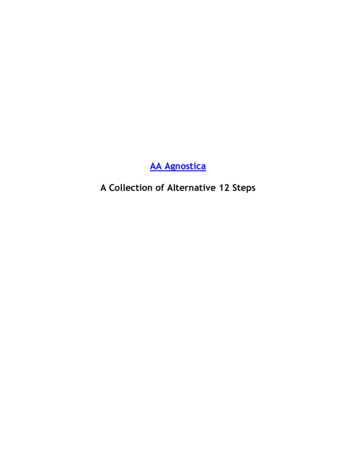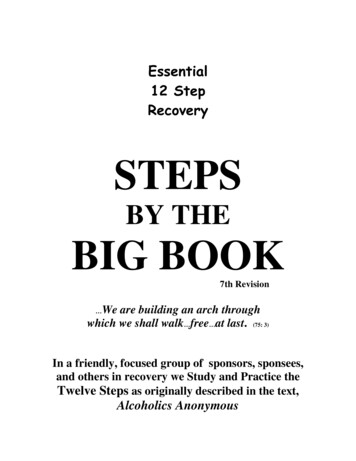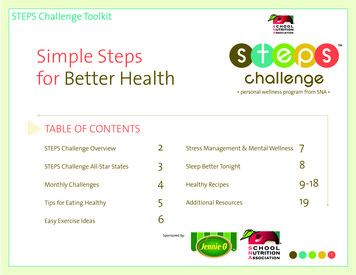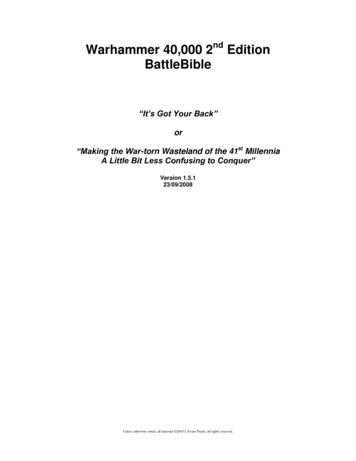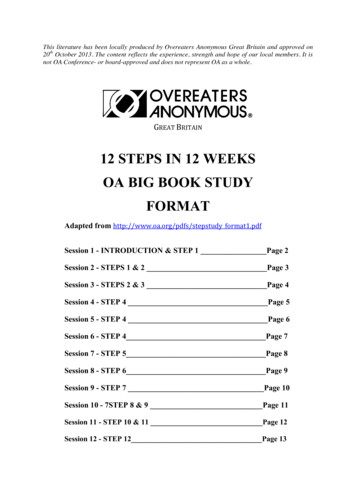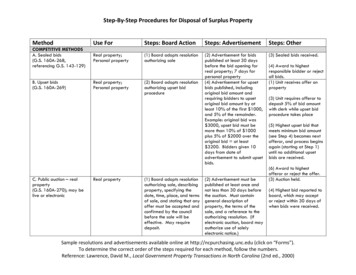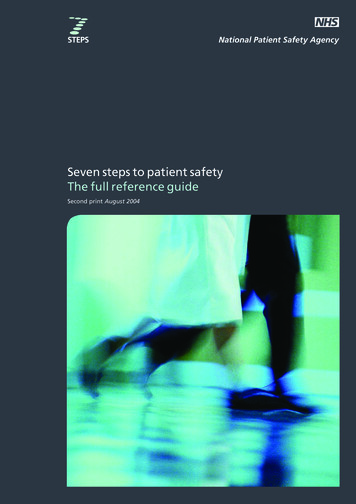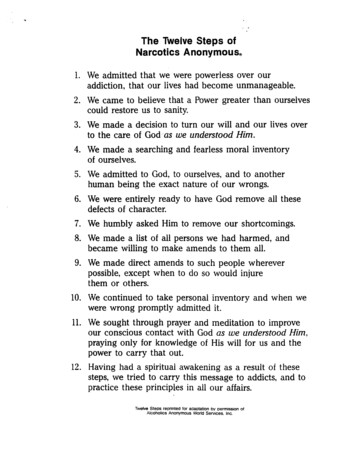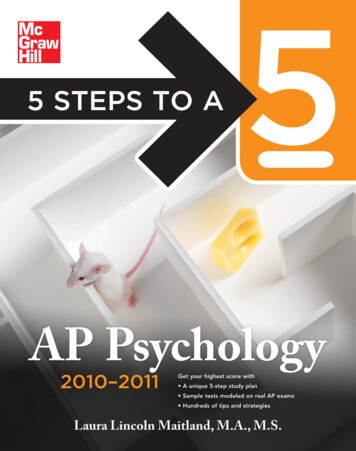
Transcription
5 STEPS TO A5AP Psychology2010–2011Laura Lincoln Maitland, M.A., M.S.New York Chicago San Francisco Lisbon London Madrid Mexico CityMilan New Delhi San Juan Seoul Singapore Sydney Toronto
Copyright 2010 by The McGraw-Hill Companies, Inc. All r.ights reserved. Except as permitted under the United States Copyright Act of 1976, no part of this publicationmay be reproduced or distributed in any form or by any means, or stored in a database or retrieval system, without the prior written permission of the publisher.ISBN: 978-0-07-162453-4MHID: 0-07-162453-8The material in this eBook also appears in the print version of this title: ISBN: 978-0-07-162454-1, MHID: 0-07-162454-6.All trademarks are trademarks of their respective owners. Rather than put a trademark symbol after every occurrence of a trademarked name, we use names in an editorialfashion only, and to the benefit of the trademark owner, with no intention of infringement of the trademark. Where such designations appear in this book, they have beenprinted with initial caps.McGraw-Hill eBooks are available at special quantity discounts to use as premiums and sales promotions, or for use in corporate training programs. To contact a representative please e-mail us at bulksales@mcgraw-hill.com.TERMS OF USEThis is a copyrighted work and The McGraw-Hill Companies, Inc. (“McGraw-Hill”) and its licensors reserve all rights in and to the work. Use of this work is subject to theseterms. Except as permitted under the Copyright Act of 1976 and the right to store and retrieve one copy of the work, you may not decompile, disassemble, reverse engineer,reproduce, modify, create derivative works based upon, transmit, distribute, disseminate, sell, publish or sublicense the work or any part of it without McGraw-Hill’s priorconsent. You may use the work for your own noncommercial and personal use; any other use of the work is strictly prohibited. Your right to use the work may be terminatedif you fail to comply with these terms.THE WORK IS PROVIDED “AS IS.” McGRAW-HILL AND ITS LICENSORS MAKE NO GUARANTEES OR WARRANTIES AS TO THE ACCURACY, ADEQUACYOR COMPLETENESS OF OR RESULTS TO BE OBTAINED FROM USING THE WORK, INCLUDING ANY INFORMATION THAT CAN BE ACCESSED THROUGHTHE WORK VIA HYPERLINK OR OTHERWISE, AND EXPRESSLY DISCLAIM ANY WARRANTY, EXPRESS OR IMPLIED, INCLUDING BUT NOT LIMITED TOIMPLIED WARRANTIES OF MERCHANTABILITY OR FITNESS FOR A PARTICULAR PURPOSE. McGraw-Hill and its licensors do not warrant or guarantee that thefunctions contained in the work will meet your requirements or that its operation will be uninterrupted or error free. Neither McGraw-Hill nor its licensors shall be liable toyou or anyone else for any inaccuracy, error or omission, regardless of cause, in the work or for any damages resulting therefrom. McGraw-Hill has no responsibility for thecontent of any information accessed through the work. Under no circumstances shall McGraw-Hill and/or its licensors be liable for any indirect, incidental, special, punitive,consequential or similar damages that result from the use of or inability to use the work, even if any of them has been advised of the possibility of such damages. Thislimitation of liability shall apply to any claim or cause whatsoever whether such claim or cause arises in contract, tort or otherwise.
CONTENTSPreface, viiAbout the Author, viiiIntroduction: The 5-Step Program, ixSTEP 1Set Up Your Study Plan1 What You Need to Know About the AP Psychology Exam, 32 How to Plan Your Time, 9STEP 2Determine Your Test Readiness3 Take a Diagnostic Exam, 17Diagnostic Exam in AP Psychology, 18STEP 3Develop Strategies for Success4 How to Approach Each Question Type, 37Section I: Multiple-Choice Questions, 37Section II: The Free-Response Questions, 39STEP 4Review the Knowledge You Need to Score High5 History and Approaches, 43Roots of Psychology, 44Schools of Psychology, 44Principal Approaches to Psychology, 45Domains of Psychology, 466 Research Methods, 51Experimental Method, 52Correlational Research, 54Case Study, 55Elementary Statistics, 55Ethical Guidelines, 597 Biological Bases of Behavior, 65Techniques to Learn About Structure and Function, 66Organization of Your Nervous System, 67Localization and Lateralization of the Brain’s Function, 68Structure and Function of the Neuron, 70The Endocrine System, 73Genetics and Evolutionary Psychology, 74Genetics and Behavior, 748 Sensation and Perception, 84Thresholds, 85Vision, 86Hearing (Audition), 88Touch (Somatosensation), 90Body Senses, 91Í iii
iv U Contents9101112131415Chemical Senses, 91Perceptual Processes, 91States of Consciousness, 102Levels of Consciousness, 103Sleep and Dreams, 103Hypnosis, 106Meditation, 106Drugs, 107Learning, 113Classical Conditioning, 114Operant Conditioning, 116Superstitious Behavior, 119Cognitive Processes in Learning, 120Biological Factors in Learning, 121Cognition, 127Models of Memory, 128Language, 134Thinking, 135Motivation and Emotion, 146Theories of Motivation, 147Physiological Motives, 149Social Motivation, 152Theories of Emotion, 153Stress and Coping, 155Positive Psychology, 156Developmental Psychology, 163Key Issues in Development, 164Methods of Studying Development, 164Physical Development, 165Theories of Cognitive Development, 168Theories of Moral Development, 170Theories of Social and Emotional Development, 171Gender Roles and Sex Differences, 174Personality, 183Personality Theories and Approaches, 184Assessment Techniques, 191Self-Concept and Self-Esteem, 193Testing and Individual Differences, 201Standardization and Norms, 201Reliability and Validity, 202Types of Tests, 203Ethics and Standards in Testing, 204Intelligence and Intelligence Testing, 205Heredity/Environment and Intelligence, 209Human Diversity, 210
Contents Í v16 Abnormal Behavior, 215Defining Abnormal Behavior, 215Causes of Abnormal Behavior, 216Types of Disorders, 21717 Treatment of Abnormal Behavior, 228Mental Health Practitioners, 228Brief History of Therapy, 229Treatment Approaches, 230Biological/Biomedical Treatments, 234Modes of Therapy, 236Community and Preventive Approaches, 23618 Social Psychology, 242Group Dynamics, 242Attribution Processes, 244Interpersonal Perception, 245Conformity, Compliance, Obedience, 247Attitudes and Attitude Change, 248Aggression/Antisocial Behavior, 249STEP 5Build Your Test-Taking ConfidenceAP Psychology Practice Exam 1 and Answers, 259AP Psychology Practice Exam 2 and Answers, 285AppendixesGlossary, 313Bibliography, 340Websites, 341
This page intentionally left blank
PREFACEWelcome to the updated 2010–2011 edition of this test preparation book for AP Psychology. Changes in this edition reflect changes to the 2010–2011 Course Description forAP Psychology from the College Board. The book has been designed so that it is userfriendly and employs the concepts psychologists know about learning and remembering tohelp you succeed. Each chapter begins with an advance organizer to help you understandthe material. Smaller sections enable you to fit what you are learning into the framework ofwhat you already know. Features that previous users found most helpful, such as the definitions in the glossary at the end of the book, questions very similar to those actually onthe AP exam, and Rapid Review at the end of each content chapter have been retained.If psychology were mainly common sense, as many people think, you wouldn’t needthis book. You wouldn’t need to study either. In fact, many concepts in psychology arecounterintuitive, the opposite of what common sense leads us to think. Actually, psychology is a real science with a substantial knowledge base. If you are currently enrolled in anAdvanced Placement Psychology course, you know how much more than listening topeople’s problems and analyzing them is included in the study of psychology, and you knowhow many hundreds of pages you need to navigate in a hard-covered course textbook. Ifyou’re not enrolled in an AP course, you may need additional support to help you selectmaterial that is likely to be tested on the May exam. In either situation, you’ll benefit fromthis book created to help you study for the Advanced Placement Exam in Psychology .This book provides you with the information on which you need to focus for takingthe Advanced Placement Exam in Psychology , and gives you opportunities to practiceanswering AP-type questions. The multiple-choice questions count for two-thirds of yourtest score, and the essays count for one-third. While multiple-choice questions usually assessyour understanding of one concept, essays test your understanding of numerous conceptsand your ability to integrate information from more than one chapter. Practice in answeringboth multiple-choice and essay questions will help you achieve on the AP exam. Read allof the material and answer all of the questions in all of the content chapters of this book,if you have enough time. Check your answers. Follow the study tips to help you learn andremember material you need to know. As the May exam approaches, take the two practicetests at the end of the book, and check your answers to see what you still need to learn.Since studying will help you succeed, it’s time to get started!Í vii
ABOUT THE AUTHORLaura Lincoln Maitland received a BA in Biological Sciences from Douglass College, anMA in Psychology from Stony Brook University, an MS in Education from CUNY-QueensCollege and a Professional Diploma from Long Island University.Retired from the Bellmore-Merrick Central H.S. District where she was lead sciencechairperson and taught Living Environment, AP Psychology, and Science Research formany years, she is currently an adjunct instructor at Hofstra University. She is also an education consultant at Cold Spring Harbor Laboratories, Long Island BOCES, and a varietyof other venues. Laura has been a workshop presenter for the College Board, the New YorkState Biology-Chemistry Professional Development Network, Cold Spring HarborLaboratory’s Dolan DNA Learning Center, the Bellmore-Merrick Central High SchoolDistrict, the New York City Board of Education, and the New York State EducationDepartment.One of the founders and early chairs of Teachers of Psychology in Secondary Schools,she chaired the committee that created National Standards for High School PsychologyCurricula. She also served on the AP Psychology Development Committee for the CollegeBoard/ETS. She received the first American Psychological Association Presidential Citationpresented to a high school teacher and the American Psychological Association DivisionTwo Excellence in Teaching Award.viii U
INTRODUCTION:THE 5-STEP PROGRAMThe BasicsLearning, thinking, solving problems, and remembering are all psychological processes.To earn the highest score of 5 on the AP Psychology exam, you’ll need to do them successfully!While the content sections of this book will help you understand concepts involved inlearning and cognition, following the 5-step program will help you apply these conceptsto maximize your success on the May exam.Introducing the 5-Step Preparation ProgramThis book is organized as a 5-step program to prepare you to succeed in the exam.These steps are designed to provide you with vital skills and strategies and the practice thatcan lead you to that perfect 5. Here are the 5 steps.Step 1: Set Up Your Study ProgramIn this step you’ll read a brief overview of the AP Psychology exam, including an outline oftopics and the approximate percentage of the exam that will test knowledge of each topic.You will also follow a process to help determine which of the following preparation programs is right for you: Full school year: September through May. One semester: January through May. Six weeks: Basic training for the exam.Step 2: Determine Your Test ReadinessIn this step you’ll take a diagnostic multiple-choice exam in psychology. This pre-testshould give you an idea of how prepared you are to take the real exam before beginningto study for the actual AP Psychology Exam . Go through the diagnostic exam step-by-step and question-by-question to build yourconfidence level. Review the correct answers and explanations so that you see what you do and donot yet fully understand.Step 3: Develop Strategies for SuccessIn this step you’ll learn strategies that will help you do your best on the exam. These strategies cover both the multiple-choice and free-response sections of the exam. Since servingon the College Board committee to design the first course of study and examinationsfor Advanced Placement Psychology , I have worked with many students and teacherswho have helped me gain insight into how they think and study. Tasks that lull you intoa false sense of security with shortcuts that may not work are NOT here.Í ix
x U Introduction Learn to read multiple-choice questions. Learn how to answer multiple-choice questions, including whether or not to guess. Learn how to plan and write the free-response questions.Step 4: Review the Knowledge You Need to Score HighIn this step you’ll learn or review the material you need to know for the test. This reviewsection takes up the bulk of this book. It contains: A comprehensive review of introductory psychology.Psychologists and educators do not agree on exactly what students should know aftercompleting an introductory course in psychology, so no book can correctly forecast whatconcepts you need to know to get 100% of the questions on the AP exam right. But I cansafely guarantee that this book includes the information that will enable you to earn a 5!The substantial knowledge you gain from studying it will significantly increase yourchances of scoring well.Step 5: Build Your Test-taking ConfidenceIn this step you’ll complete your preparation by testing yourself on practice exams. I haveprovided you with two complete exams in psychology, and scoring guides for them.Although these practice exams are not reproduced questions from actual AP Psychologyexams, they mirror both the material tested by AP and the way in which it is tested.Finally, at the back of this book you’ll find additional resources to aid your preparation.These include: A brief bibliography. A list of websites related to the AP Psychology exam. A glossary of terms related to the AP Psychology exam.Introduction to the Graphics Used in this BookTo emphasize particular skills and strategies, we use several icons throughout this book.An icon in the margin will alert you that you should pay particular attention to theaccompanying text. We use these three icons:KEY IDEASTRATEGYTIPThis icon points out a very important concept or fact that you should not pass over.This icon calls your attention to a strategy that you may want to try.This icon indicates a tip that you might find useful.Boldfaced words indicate terms that are included in the glossary at the end of this book.Throughout the book you will also find marginal notes, boxes, and starred areas. Pay closeattention to these areas because they can provide tips, hints, strategies, and further explanations to help you reach your full potential.
STEP1Set Up Your Study PlanCHAPTERCHAPTER12What You Need to Know About the AP Psychology ExamHow to Plan Your Time
This page intentionally left blank
CHAPTER1What You Need to Know About theAP Psychology ExamIN THIS CHAPTERSummary: Learn what topics are tested, how the test is scored, and basictest-taking information.Key ideasKEY IDEA% AP Psychology is equivalent to a college-level introductory psychologycourse.% Most, but not all, colleges will award credit for a score of 4 or 5.% Multiple-choice questions account for two-thirds of your final score.% One-quarter of a point is deducted for each wrong answer onmultiple-choice questions.% Free-response questions account for one-third of your final score.% Your composite score on the two test sections is converted to a scoreon the 1-to-5 scale.Background InformationThe College Board’s Advanced Placement (AP) program enables high school students tostudy college-level subjects. Most colleges grant credit, placement, or both for qualifyingAP exam grades. You may want to check with the colleges of your choice to find out theirpolicies. Enrollment in AP Psychology has increased annually since its inception to becomeone of the most popular of 37 AP courses and exams offered.Í 3
4 U STEP 1. Set Up Your Study PlanSome Frequently Asked Questions about theAP Psychology ExamWhy Take the AP Psychology Exam?STRATEGY“I’m glad I tookAP Psychology inhigh school. Iteased mytransition tocollege. I knewthe level of workI needed to do tosucceed and whatstudying for acollege final islike beforeenrolling.”–Kim,college studentAP Psychology is an exciting course to take not only because it gives you an opportunity tounderstand your own behavior and mental processes better, but also because it enables youto learn more about other people and animals. Benefits of taking such a challenging coursecan include strengthening your transcript, proving to yourself that you can do it, and starting college with some credit. Admissions officers from Adelphi University to Yale Universityhave told me that their number one criterion for admissions decisions is the strength of anapplicant’s high school program.Additional benefits are sometimes offered. Some high schools weight or scale AP coursegrades. Because some colleges charge per credit, you can save money. Getting three or morecredits for the price of the exam is a good value.The College Board reports, “Studies have shown that AP students are more likelyto maintain a high grade point average and graduate from college with honors than theircollege classmates of similar ability.”What Is the Format of the Exam?The following table summarizes the format of the AP Psychology exam.Table 1.1“I knew that as apre-med Iwouldn’t be ableto fit psychologyinto my collegeprogram, so Iwanted to take itin high school.My knowledge ofpsychology helpsme understandmy patients.”—Dr. Jerry C.,formerAP studentAP PsychologySectionI. Multiple-Choice QuestionsII. Free-Response QuestionsQuestions1002Time Limit1 hour and 10 minutes (70 minutes)50 minutesThe exam is 2 hours long. During the first 70 minutes, you have 100 multiple-choicequestions to answer. At the end of the 70 minutes, your booklet and answer sheet will becollected. However, no matter how early you finish this first part of the exam, you cannotbegin the free-response questions (essays) early. The multiple-choice section counts fortwo-thirds of your score. If you have time remaining after you complete the questions,you can go back to those you were uncertain about or want to reread. You are limited to50 minutes to answer two required essay questions.Who Writes the AP Psychology Exam?Development of each AP exam is a multi-year effort that involves many education and testingprofessionals and students. At the heart of the effort is the AP Psychology DevelopmentCommittee, a group of highly regarded college and AP high school teachers from diversebackgrounds who are typically asked to serve for 3 years. The committee and experiencedtest-item writers create a large pool of multiple-choice questions. With the help of psychometricians (measurement psychologists) at Educational Testing Service (ETS), these questions are then pre-tested with college students who are enrolled in introductory psychologyat selected colleges and universities. Questions are evaluated for accuracy, appropriateness,clarity, and assurance that there is only one possible answer. Data from pre-tests allow eachquestion to be categorized by degree of difficulty.In general, the easiest questions to answer are at the beginning of Section 1, and the mostdifficult questions at the end. After additional development and refinement, Section I of theexam is ready to be administered.Numerous free-response questions (essay questions) are written for possible inclusionon the exams. After these questions are edited, discussed by committee members, and
What You Need to Know About the AP Psychology Exam Í 5pre-tested with college psychology classes, the committee chooses essay questions for inclusion on a specific AP Psychology exam. They ensure that the free-response questions cutacross content areas, are well presented and unambiguous, as well as considerably differentfrom each other. Only free-response questions that will allow for clear and equitable grading by the AP readers (scorers) are selected.After exams have been scored, the AP Psychology Development Committee and ETSevaluate the test results. The College Board can use the results to further course development in high schools and to plan future exams.What Is Going to Appear on the Exam?KEY IDEAETS and the College Board periodically survey colleges/universities throughout the UnitedStates and around the world to find out what is being taught in introductory psychologycourses in order to ensure that what is being taught in the AP course is comparable. Theexam presumes the equivalent of at least one term/semester of college-level work.Based on the latest information, the AP Psychology Development Committee hasupdated the course description and point distribution outline for the AP Psychology examsin May 2010 and May 2011.Content review chapters in this test preparation book conform to their outline. Thepercentage range in front of each topic represents the number of questions about it that willbe asked on the exam. For example, 2, 3, or 4 questions will deal specifically with historyand approaches; and 8, 9, or 10 will deal with research methods.2–4%history and approaches8–10%research methods8–10%biological bases of behavior6–8%sensation and perception2–4%states of otivation and emotion7–9%developmental psychology5–7%personality5–7%testing and individual differences7–9%abnormal behavior5–7%treatment of abnormal behavior8–10%social psychologyTypically free-response questions require you to make connections among conceptsfrom multiple topics, or to apply concepts from different theoretical frameworks to design,analyze, or critique an experiment or other type of research study.Who Grades My AP Psychology Exam?The multiple-choice questions are scored by computer, but this is not possible for essayquestions. These free-response questions are scored by a select group of experienced collegeprofessors of introductory psychology and AP Psychology teachers who gather at the
6 U STEP 1. Set Up Your Study PlanAP Reading for several days in June to assess the papers. Each of these faculty consultantsspends a day or so getting trained on one question and one question only. Because eachReader becomes an expert on a single question, and because each essay booklet is anonymous,this process provides a very consistent (reliable) and unbiased scoring of that question.During a typical day of grading, a random sample of each consultant’s scored papers isselected and cross-checked by other experienced “Table Leaders” to ensure that consistencyis maintained across all scorers throughout the Reading. Each Reader’s scores on a givenquestion are also statistically analyzed to make sure that he/she is not giving scores that aresignificantly higher or lower than the mean scores given by other Readers of that question.All measures are taken to maintain consistency and fairness for your benefit. Your answersto the two questions will be scored by at least two different consultants.AP Psychology exams are administered to college psychology students at the endof their introductory psychology course, so that their performance on the AP Exam canbe compared to their performance in the college course (as measured by their test andcourse grades). This information is used to guide the assignment of the AP exam grades1–5 to raw scores.Will My Exam Remain Anonymous?Absolutely. Even if your high school teacher were to randomly rate one of yourfree-response questions at the Reading, there is virtually no way he/she would recognizethat the paper belongs to you. To a faculty consultant, each student is a number and to thecomputer, each student is a bar code.What About That Permission Box on the Back?The College Board uses some exams to help train high school teachers so that they can helpthe next generation of psychology students to avoid common mistakes. If you check thisbox, you simply give permission to use your exam in this way. Even if you give permission,your anonymity is still maintained.How Is My Multiple-Choice Answer Sheet Scored?The multiple-choice section of the psychology exam is 100 questions and is worthtwo-thirds of your final score. Your answer sheet is run through the computer, which addsup your correct responses and subtracts a fraction for each incorrect response. For everyincorrect answer that you give, one-quarter of a point is deducted. The total is a raw scoreas follows:Section I Raw Score Nright 0.25NwrongHow Is My Free-Response Exam Scored?Your performance on the free-response section is worth one-third of your final score. Tworequired essays comprise this section. Although the two questions are typically given equalweight (25 each), they may be scored on different point scales. As a result, if Essay #1 hasnine points that are scored, the number of points earned toward the total exam score forthat essay would be Score #1 x 2.778. The multiplier for each free-response question isdetermined by dividing 25 by the maximum number of points in the scoring rubric or scoring guide. The table that follows indicates multipliers for essay questions with differentpoint maximums.
What You Need to Know About the AP Psychology Exam Í 7Table 1.2Points/Multiplier TableMaximum 73122.083Section II Raw Score (Score #1 Correct Multiplier) (Score #2 Correct Multiplier)So How Is My Final Grade Determined and What Does It Mean?To determine your Composite Raw Score, add the Section I Raw Score and the Section IIRaw Score. Based on the composite scores of all of the test takers, the Chief Reader sets fourcut points that divide the composite scores into groups. Rather than report your composite score, the College Board reports to you one of five numbers assigned to your compositescore, based on the cut points: 5 indicates you are extremely well qualified.4 indicates you are well qualified.3 indicates you are qualified.2 indicates you are possibly qualified.1 indicates no recommendation.Below is a rough example of a conversion chart, and as you complete the practiceexams, you may use this to give yourself a hypothetical grade. Keep in mind that the conversion changes slightly every year to adjust for the difficulty of the questions. You shouldreceive your grade in early July.Table 1.3CompositeScore RangeGrade Guide Table—AP PsychologyAP GradeInterpretation96–1505Extremely Well Qualified for College Credit74–954Well Qualified55–733Qualified36–542Possibly Qualified0–351No Recommendation
8 U STEP 1. Set Up Your Study Plan“I’m sorry Ididn’t take theAP PsychologyExam. Thecollege I chosedid not givecredit for theexam, so Iskipped it. WhenI transferred to adifferent collegeas a sophomore,I found out thatI could’ve gottensix credits frommy new school.What a loss!”–Andrea, formerAP studentExampleIn Section I of Practice Exam 1, if you answered 76 questions correctly and12 questions incorrectly, your Section I score would be 73.Section I Raw Score 76 – (0.25 12) 73In Section II of Practice Exam 1, if you earned 7 out of 10 points on Essay 1, and6 out of 8 points on Essay 2, your Section II score would be 36.25.Section II Raw Score (7 2.5) (6 3.125) 17.5 18.75 36.25Composite Score 73 36.25 109.25, which would be assigned a 5.What Should I Bring to the Exam?On exam day, I suggest bringing the following items: Several pencils and an eraser that doesn’t leave smudges. Black or blue colored pens for the free-response section. A watch so that you can monitor your time. You never know if the exam room will havea clock on the wall that keeps accurate time. Your school code. Your photo identification and social security number. Tissues. Your quiet confidence that you are prepared.Avoid bringing electronic data and communications devices, and study materials to thetesting site.
CHAPTER2How to Plan Your TimeIN THIS CHAPTER:Summary: The right preparation plan for you depends on your study habitsand the amount of time you have before the test.Key IdeaKEY IDEA% Choose the study plan that’s right for you.Three Approaches to Preparing for AP ExamsWhat kind of preparation program for the AP exam should you follow? Should youcarefully follow every step, or are there perhaps some steps you can bypass? That dependsnot only on how much time you have, but also on what kind of student you are. No oneknows your study habits, likes, and dislikes better than you. You are the best one to decidethe approach for you to adopt to prepare successfully for the Advanced PlacementPsychology Exam. This chapter presents three possible study plans, labeled A, B, and C.Look at the brief profiles below. These may help you determine which of these three plansis right for you.You’re a Full-School-Year Prep Student If:1. You are the kind of person who likes to plan for everything very far in advance.2. You arrive at the airport hours before your scheduled flight because you never knowwhen something can happen.3. You like detailed planning and to have everything in its place.4. In order to be comfortable, you must feel thoroughly prepared.Í 9
10 U STEP 1. Set Up Your Study Plan5. You arrive early for appointments.6. You hate surprises.If you fit this profile, consider Plan A.You’re a One-Semester Prep Student If:1. You plan a graduation party or vacation a few months in advance so that people youinvite will be likely to be available, and you can get everything you need.2. You generally get t
Welcome to the updated 2010–2011 edition of this test preparation book for AP Psy-chology. Changes in this edition reflect changes to the 2010–2011 Course Description for AP Psychology from the College Board. The book has been designed so that it is user friendly and employs the conc

